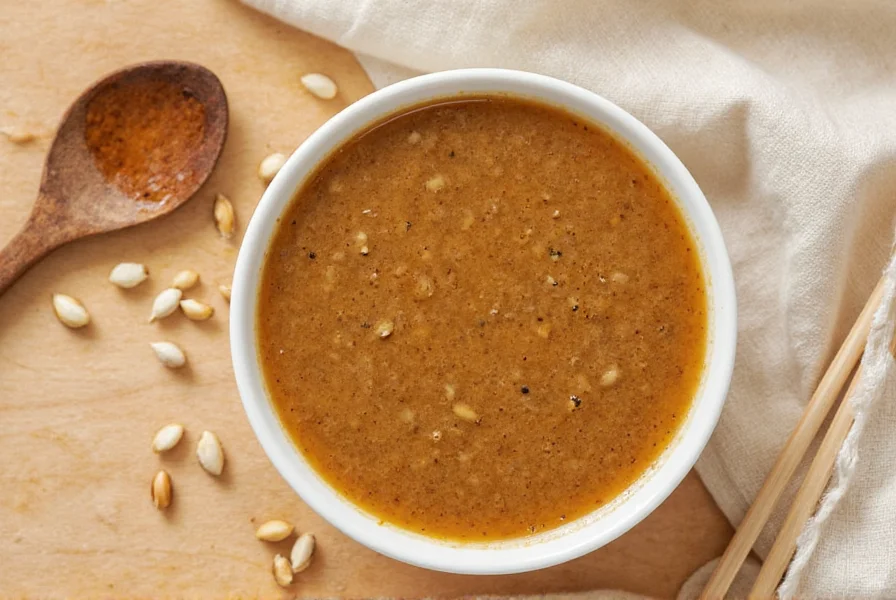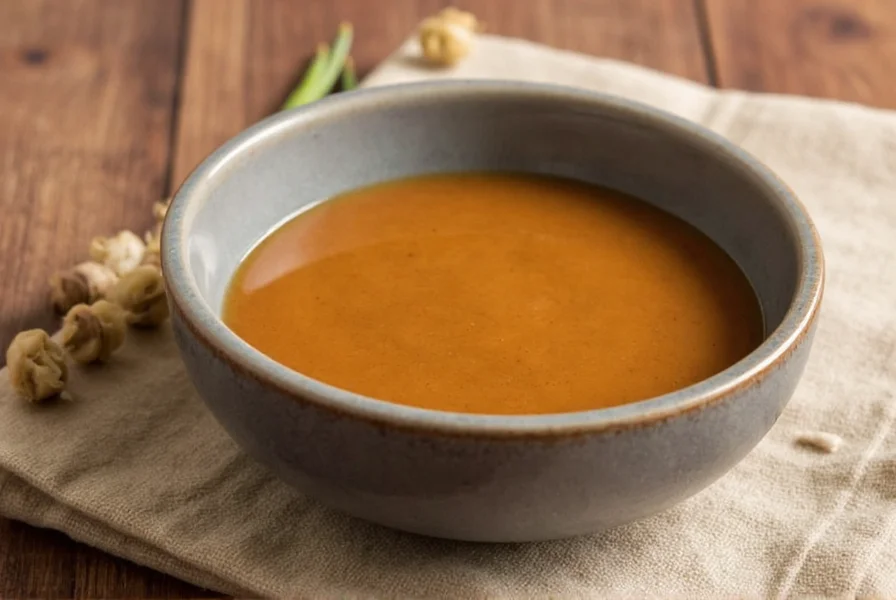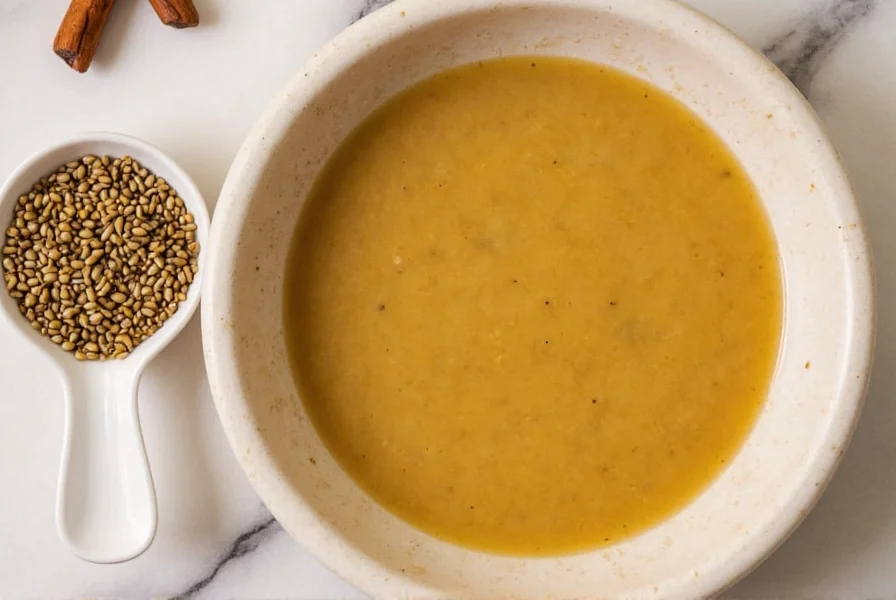If you've ever wondered what gives Asian-inspired dishes their distinctive nutty, spicy-sweet flavor profile, sesame ginger sauce is often the secret ingredient. This popular sauce blends the earthy richness of sesame with the bright heat of fresh ginger, creating a complex flavor that enhances everything from stir-fries to salad dressings.
Understanding Sesame Ginger Sauce Flavor Profile
Sesame ginger sauce delivers a harmonious balance of five key taste elements:
| Taste Element | Primary Ingredients | Flavor Contribution |
|---|---|---|
| Umami/Savory | Soy sauce, sesame oil | Deep, rich base flavor |
| Sweet | Honey, brown sugar, or maple syrup | Balances acidity and heat |
| Spicy | Fresh ginger, garlic | Bright, warming heat |
| Nutty | Sesame oil, toasted sesame seeds | Earthy richness |
| Sour | Rice vinegar, citrus juice | Acidity for balance |
The magic happens when these elements combine to create a sauce that's greater than the sum of its parts. Unlike many store-bought versions that rely heavily on sugar and preservatives, authentic sesame ginger sauce maintains a delicate balance that enhances rather than overwhelms your dishes.
Essential Ingredients in Quality Sesame Ginger Sauce
While recipes vary, the foundation of excellent sesame ginger sauce includes:
- Fresh ginger - Provides the signature spicy warmth (never substitute dried ginger for fresh in quality sauce)
- Toasted sesame oil - Use 100% pure sesame oil, not "sesame-flavored" oil which contains vegetable oil
- Low-sodium soy sauce - Allows better control of salt content
- Natural sweeteners - Honey, maple syrup, or brown sugar in moderation
- Rice vinegar - Adds necessary acidity without overpowering
- Garlic - Complements the ginger with its own distinctive flavor
- Sesame seeds - For texture and visual appeal (optional)
Avoid sauces containing high-fructose corn syrup, artificial colors, or excessive preservatives. The best sesame ginger sauce recipes use recognizable ingredients you'd find in your own pantry.

Top Culinary Applications for Sesame Ginger Sauce
Sesame ginger sauce versatility makes it a kitchen staple. Here's how to use it effectively:
As a Marinade
This sauce works exceptionally well as a sesame ginger marinade for chicken, beef, or tofu. The acid in the vinegar or citrus helps tenderize proteins while the oil carries flavors deep into the food. For best results, marinate proteins for 30 minutes to 2 hours—any longer and the acid can start to "cook" the surface.
In Salad Dressings
One of the most popular applications is as a sesame ginger dressing for salads. Whisk 3 parts sauce with 1 part neutral oil (like grapeseed) to create a balanced dressing that won't overwhelm delicate greens. This dressing particularly complements spinach salads with strawberries, mandarin oranges, and almonds.
Stir-Fry Sauce Base
When making stir-fries, add 2-3 tablespoons of sauce during the final minute of cooking. The heat intensifies the flavors while preserving the fresh ginger notes. This homemade sesame ginger sauce recipe works better than store-bought versions because it lacks thickeners that can make sauces gummy when heated.
Dipping Sauce
Serve it as a dipping sauce for spring rolls, dumplings, or potstickers. For a restaurant-quality experience, thin the sauce slightly with warm water or broth to achieve the perfect dipping consistency.
Simple Homemade Sesame Ginger Sauce Recipe
Creating your own sesame ginger sauce from scratch takes just 10 minutes and yields superior flavor to most commercial options:
Ingredients
- ¼ cup low-sodium soy sauce
- 2 tablespoons rice vinegar
- 1½ tablespoons honey or maple syrup
- 1 tablespoon toasted sesame oil
- 1 tablespoon fresh ginger, finely grated
- 2 cloves garlic, minced
- 1 teaspoon sesame seeds
- 1-2 tablespoons water (to adjust consistency)
Instructions
- Whisk together soy sauce, rice vinegar, and honey until honey dissolves
- Slowly add sesame oil while whisking to emulsify
- Stir in fresh ginger, garlic, and sesame seeds
- Add water as needed to reach desired consistency
- Let sit for 15 minutes to allow flavors to meld
This basic easy sesame ginger sauce recipe yields approximately ½ cup of sauce. Store in an airtight container in the refrigerator for up to two weeks. The flavors actually improve after 24 hours as the ingredients continue to meld.

Sesame Ginger Sauce vs. Similar Condiments
Many people confuse sesame ginger sauce with other Asian-inspired sauces. Here's how it differs:
- Sesame ginger vs teriyaki: Teriyaki is sweeter and thicker with a stronger soy profile, while sesame ginger emphasizes the nutty sesame and spicy ginger notes
- Sesame ginger vs ponzu: Ponzu is citrus-forward with minimal sesame, while sesame ginger balances citrus with prominent sesame flavors
- Sesame ginger vs hoisin: Hoisin is thick, sweet, and made from fermented soybeans, while sesame ginger is thinner and highlights fresh ingredients
Understanding these differences helps you select the right sauce for your culinary application. For instance, sesame ginger sauce for salmon works beautifully because the nutty flavors complement the fish's richness, while teriyaki might overpower it.
Storage and Shelf Life Guidelines
Proper storage maintains your sauce's quality:
- Store in an airtight container in the refrigerator
- Homemade versions last 10-14 days; store-bought lasts 3-4 weeks after opening
- Freeze in ice cube trays for longer storage (up to 3 months)
- Always use clean utensils to prevent contamination
Signs your sauce has spoiled include mold growth, separation that doesn't reincorporate when shaken, or an off smell. When in doubt, throw it out—fresh ginger can spoil relatively quickly.
Nutritional Considerations
A typical 2-tablespoon serving of sesame ginger sauce contains approximately:
- 60-80 calories
- 8-12g carbohydrates
- 0-1g protein
- 3-5g fat (primarily from sesame oil)
- 400-600mg sodium
For a healthy sesame ginger sauce alternative, reduce the sweetener by half and use reduced-sodium soy sauce. The sesame oil provides healthy monounsaturated fats, but portion control matters due to the sodium content.
Troubleshooting Common Sesame Ginger Sauce Issues
Encountering problems with your sauce? Try these solutions:
- Too salty: Add a squeeze of fresh lime juice or a small amount of honey to balance
- Too sweet: Increase rice vinegar or add a dash of soy sauce
- Too thick: Thin with warm water, broth, or additional rice vinegar
- Weak ginger flavor: Add freshly grated ginger (not powdered) and let sit 15 minutes
- Separation: Shake vigorously or re-emulsify with a small amount of neutral oil
Remember that the quality of your ingredients directly impacts the final product. Using fresh, high-quality ginger and pure sesame oil makes the most significant difference in flavor.
Frequently Asked Questions
What's the difference between sesame oil and toasted sesame oil?
Regular sesame oil is made from raw sesame seeds and has a light, neutral flavor. Toasted sesame oil comes from roasted seeds and has a much stronger, nuttier flavor that's essential for authentic sesame ginger sauce. Never substitute one for the other in this application, as toasted sesame oil provides the distinctive flavor profile.
Can I make sesame ginger sauce without soy sauce?
Yes, for a soy-free version, substitute coconut aminos (which has a similar umami profile but is soy-free) or a mixture of fish sauce and water (1:3 ratio). For a completely different approach, try a miso-based version using white miso paste diluted with water or broth, though this creates a distinctly different flavor profile than traditional sesame ginger sauce.
How can I make my sesame ginger sauce thicker for dipping?
To thicken sesame ginger sauce for dipping applications, create a slurry with 1 teaspoon cornstarch mixed with 1 tablespoon cold water. Whisk this into the sauce and heat gently until it reaches your desired consistency. Alternatively, reduce the sauce by simmering it gently for 3-5 minutes to concentrate flavors and thicken naturally without additives.
Is sesame ginger sauce gluten-free?
Most sesame ginger sauce recipes can be made gluten-free by using tamari or a certified gluten-free soy sauce instead of traditional soy sauce. Always check labels on store-bought versions, as some may contain wheat or be processed in facilities with gluten-containing products. The homemade version described in this article is naturally gluten-free when using gluten-free soy sauce substitute.
What dishes pair best with sesame ginger sauce?
Sesame ginger sauce complements grilled salmon, chicken stir-fries, roasted vegetables, and noodle dishes exceptionally well. It also makes an excellent dressing for Asian slaw or as a dipping sauce for spring rolls. For a creative application, try it as a base for grain bowls or drizzled over roasted sweet potatoes. The sauce's versatility makes it suitable for both traditional Asian dishes and fusion cuisine.











 浙公网安备
33010002000092号
浙公网安备
33010002000092号 浙B2-20120091-4
浙B2-20120091-4